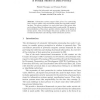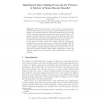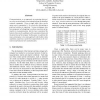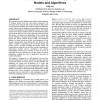119
click to vote
BNCOD
2009
15 years 1 months ago
2009
Abstract. Privacy has become increasingly important to the database community which is reflected by a noteworthy increase in research papers appearing in the literature. While rese...
ASIACRYPT
2000
Springer
15 years 4 months ago
2000
Springer
This paper takes a closer look at Rivest's chaffing-and-winnowing paradigm for data privacy. We begin with a definition which enables one to clearly determine whether a given ...
110
Voted
ERSHOV
2006
Springer
15 years 4 months ago
2006
Springer
Information systems support data privacy by constraining user's access to public views and thereby hiding the non-public underlying data. The privacy problem is to prove that ...
GLOBE
2009
Springer
15 years 5 months ago
2009
Springer
P2P systems are increasingly used for efficient, scalable data sharing. Popular applications focus on massive file sharing. However, advanced applications such as online communiti...
94
Voted
ECAI
2004
Springer
15 years 6 months ago
2004
Springer
Spontaneous formation of peer-to-peer agent-based data mining systems seems a plausible scenario in years to come. However, the emergence of peer-to-peer environments further exace...
115
click to vote
MADNES
2005
Springer
15 years 6 months ago
2005
Springer
With the rapid advance of the Internet, a large amount of sensitive data is collected, stored, and processed by different parties. Data mining is a powerful tool that can extract ...
103
Voted
NDSS
2006
IEEE
15 years 6 months ago
2006
IEEE
Volunteer distributed computations utilize spare processor cycles of personal computers that are connected to the Internet. The resulting platforms provide computational power pre...
IEEECIT
2006
IEEE
15 years 6 months ago
2006
IEEE
K-anonymisation, as an approach to protecting data privacy, has received much recent attention from the database research community. Given a single table, there can be many ways t...
169
Voted
VLDB
2007
ACM
15 years 7 months ago
2007
ACM
This tutorial presents the definition, the models and the techniques of location privacy from the data privacy perspective. By reviewing and revising the state of art research in ...
103
click to vote
CISC
2007
Springer
15 years 7 months ago
2007
Springer
Abstract. Key privacy is a notion regarding the privacy of the owner of a public key, which has important applications in building (receiver) anonymous channels, or privacy-enhance...





